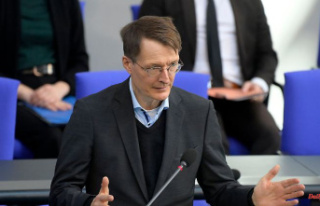In a few months, Ukraine will need Western tanks very badly, says military expert Gustav Gressel. In his view, the exchange of rings with Greece, with which the German government avoids delivering tanks directly to Greece, is a sheer waste of material. He only exists "to make people like Ralf Stegner and Rolf Mützenich happy in the SPD".
ntv.de: Foreign Minister Annalena Baerbock recently stated that it is now important to support the Ukrainian air defense system, which is more urgent than tank deliveries. Is she correct in that statement?
Gustav Gressel: The Ukrainian army captured quite a lot of Russian main battle tanks during their offensive, that's right. She can still drive a bit with them, that's true. So the situation with main battle tanks is okay in the short term, but we have to think further.
Go ahead.
After the first two weeks of the war, it was already clear that this war would last for a long time. For the Ukraine, this results in the following problem: spare parts and ammunition are scarce for many systems of Soviet design, because there are very few production facilities for these types outside of Russia. This applies to armored personnel carriers or battle tanks as well as to air defense systems. Some classes of ammunition cannot be manufactured outside of Russia at all.
Could such production possibilities be created?
Recreating anti-aircraft missiles with all their complex internal components is not trivial. It would take years. We don't have any technical documentation on the components. The moment the last rocket of this type has been fired, the furnace is off, end of terrain. Then a western system is needed.
Is the conclusion to be drawn from this: in the coming months Ukraine will have to convert to western systems in all arms?
That's the challenge. With some devices, the situation is not so precarious, there is a little more time. But in the medium term it affects all weapon systems. In the further course of this war, Ukraine must necessarily westernize. Right from the start, anti-aircraft defense was the most urgent requirement, because there are no western rearmament options at all.
But?
But that doesn't mean that we don't have to be active in relation to other genres, such as tanks. If we look at the situation with the tanks, Ukraine is currently using different types of Soviet-made tanks: There are no spare parts for the T-80 and T-90 in the West. Ukraine still gets spare parts from Poland and the Czech Republic for the T-72. The T-64, on the other hand, was the standard tank of the Ukrainian army and was formerly produced in Kharkiv. The Russians already destroyed the plant in March, including the spare parts store. Maintenance is therefore difficult. That's why it's already clear: in a few months Ukraine will urgently need western tanks.
What if you give it to them?
Sure, then the public pressure will be so great that we have to deliver anyway. But then we don't do it in the way that would actually be required, namely in a forward-looking, strategic manner, with logistics that have already been set up and soldiers already trained, but then something is botched up at short notice to save the Ukraine from sinking. This could be done differently, namely with foresight. But not with this chancellor.
Olaf Scholz is the problem?
For this answer I have to go back a bit: from the first day of this war, armored formations were a very important element of Ukrainian defense. Without mechanized reserves, Kyiv would have been encircled and probably also fallen. However, these devices have now been heavily used. On a net basis, Ukraine loses 75 main battle tanks per month.
What about the armored personnel carriers?
Even then, the losses are very high. But there is another problem: Soviet-designed armored personnel carriers are hardly survivable. If a BMP-1 receives an enemy hit, it usually burns out with the entire crew. The same applies to several other Soviet tank types.
Is that what causes the high losses on both sides?
Exactly, and that leads to a problem, because it takes longer to train an experienced tank crew than to produce a main battle tank. So the soldiers in the tank are the scarcer resource. In order to protect them better, Ukraine urgently needs to switch to western tanks. But what is the federal government doing? She plans to squander the German martens repaired by Rheinmetall in ring exchanges with Greece.
In return, the Ukraine will get the BMP-1 from the Greeks, i.e. their old standard tank. The argument here: the Ukrainian soldiers are familiar with this tank and can drive off immediately.
That's true, but there are still some arguments against it: First, these tanks from Greece are in poor condition, only make good use of them as a spare parts store. Secondly, the BMP-1 is by far the inferior system to the Marder.
In what way?
If we compare both: Firstly, the Marder has a well-functioning armament. The cannon of the BMP-1, on the other hand, hits at 50-100 meters, not a step further in the wind, it is far inferior to the Marder. Secondly, the marten has good optics through which I can see something. I don't see anything on the BMP-1. Third, the marten is survivable and can take a few hits. The BMP-1, on the other hand, as we have already mentioned, explodes on the first hit and burns out. Often the Ukrainian soldiers do not go into battle in the tank, but instead sit on the outside of it.
These videos, where soldiers are sitting on the tanks, are circulating on the Internet, making the situation almost "relaxed".
The opposite is the case: the soldiers sit on the tank because the chance of surviving is higher outside. Fourth, the marten is faster and fifth, it has a larger volume, so more soldiers can fit inside. In summary: This ring exchange is a pure waste of material.
Then why is it carried out?
To make people like Ralf Stegner and Rolf Mützenich happy in the SPD.
Are you serious?
Absolutely. The SPD would like to get rid of the martens that Rheinmetall repaired and that are now standing by in the yard as quickly as possible. Because then you no longer have to discuss a delivery to Ukraine. A ring exchange from Marder to BMP-1 has nothing to do with supporting Ukraine. This ring exchange helps Greece and helps the SPD, otherwise it doesn't help anyone.
Would you say it's harmful instead?
Since the marten is not only present at Rheinmetall, but also in the Bundeswehr, it would also be a future perspective for Ukraine. Maintenance and supplies would be possible and secured. This perspective is taken away from Ukraine by the exchange of rings.
If we look at the situation with the main battle tanks, you are calling for Ukraine to switch to the German Leopard 2. Why everything from Germany? Wouldn't the Leclerc from France or the British Challenger also be suitable?
Production of the French Leclerc and the British Challenger has both ended, so they are no longer built. That's why I can only remove spare parts from old vehicles. That would be a strong disadvantage compared to the Leopard-2. With this tank I can also give Ukraine a perspective for the future, since it is still being manufactured and in Europe there is also the infrastructure for maintenance.
Can you explain that briefly?
The leopard is relatively widespread, it can be found in a total of 13 European countries, including Norway, Greece, Poland, Portugal, Sweden, Spain, Denmark and Finland. If each of the countries only gives up a small number of tanks, you would already get a critical mass together. A huge advantage of this type of tank: there are still three production lines in Europe - in Germany, Spain and Greece. This would make the delivery of spare parts very quick.
What would have to happen for the conversion and when?
Such a conversion to western systems takes time and good cooperation. I have to convene a Leopard 2 summit and coordinate it very well. With sufficient planning, I can then get a number of quickly available vehicles on which the Ukrainians can train. Then I set up the logistics chain for spare parts - it all takes months.
From your point of view, you should start now so that the Ukrainian troops can really switch to the Leopard sometime in 2023?
The Iris-T SLM air defense system is a good example of how important it is to plan ahead: the decision to deliver it was made in May. The first system was delivered in October, and Ukraine will not get the next ones until next year. Despite all the criticism I level at Scholz, he made a quick and correct decision in this case. Ukraine must pose a constant threat to high-flying Russian fighter jets, and the Iris-T is perfect for that. The missiles and spare parts are produced in Germany, so there will be no shortage of ammunition, and that is extremely important. The federal government deserves real praise, clumsy as it is with the tanks.
Frauke Niemeyer spoke to Gustav Gressel












